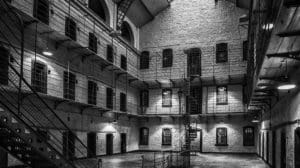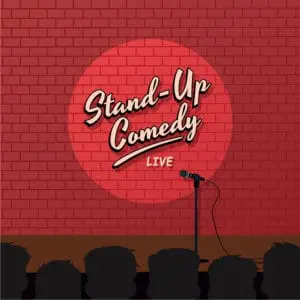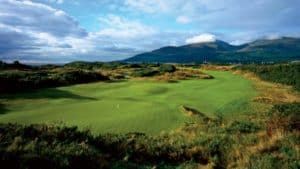Myth Meets Medium: Exploring Irish Folklore’s Influence on Modern Media

Updated On: April 22, 2024 by Panseih Gharib
Irish folklore, a tapestry woven with tales of magic and mysticism, continues to cast its spell over contemporary media, enchanting audiences worldwide. The enduring appeal of these stories lies in their ability to transcend time, merging ancient wisdom with modern creativity. As we delve into the heart of Irish folklore, we find themes that resonate with universal human experiences, making them ripe for retelling through various forms of media. These narratives offer more than just entertainment; they present moral compasses, serve as cultural touchstones, and contribute to the ongoing dialogue between the past and the present.
The depiction of Irish mythology in contemporary media is not merely a resurgence; it is a dynamic reinterpretation that breathes new life into age-old legends. From literature and film to video games and virtual reality, these myths are being reimagined, ensuring their survival and relevance in a rapidly changing world. We see key mythological figures finding new homes in these mediums, their stories unfolding against backdrops that are at once familiar and enchanting. This marriage of myth with modern-day storytelling mediums showcases the versatility of Irish folklore and its profound impact on Irish arts and national identity.
The Roots of Irish Folklore

Before we explore how Irish folklore has been interwoven into contemporary media, it’s essential to understand its origins. These historical and cultural roots give us a framework for how tradition and belief have been preserved through time.
Historical Overview
Irish folklore has a lineage that stretches back through the centuries, deeply entwined with Ireland’s long and complex history. An oral tradition has captured and communicated key events and societal changes. This living record includes tales of epic heroes, fabled creatures, and the profound wisdom of the ancestors, which have been passed down to bind the present to the past and ensure the continuation of a shared heritage.
Cultural Genesis
The genesis of folklore in Ireland is as much about the culture as it is about the stories themselves. It arises from a confluence of tradition and belief, where each story or myth reflects the deeper heritage and ethos of the Irish. With a vibrant tapestry of customs, the folklore of Ireland carries forward the values and lessons of the Celtic civilisation, imbuing them with a timeless quality that resonates through generations.
Key Figures in Irish Mythology

In Irish mythology, the tapestry of tales is adorned with legendary heroes, powerful gods, and goddesses who have captured the imagination through the ages. These figures exemplify the rich folklore that has been integral to Irish culture and influences various forms of contemporary media today.
Legendary Heroes
Cú Chulainn is one of the most celebrated heroes, known for his superhuman strength and exploits in the Ulster Cycle. As a figure of bravery, he represents the archetype of the warrior hero, honouring values like loyalty and honour.
Fionn mac Cumhaill is another central hero. He is a legendary hunter and warrior famed for his wisdom and leadership. He founded the Fianna, a band of noble warriors that played a prominent role in Irish folklore.
Gods and Goddesses
In the pantheon of Irish deities, we find The Dagda, a prominent figure revered as an all-powerful god. His attributes include mastery over life and death, abundance, and wisdom.
Brigid, daughter of The Dagda, stands out as a multifaceted goddess associated with healing, fertility, poetry, and crafts. She exemplifies the interweaving of the divine with everyday life, embodying inspiration and creativity.
By considering these key figures, we come to appreciate the depth and nuance of Irish mythology, which continues to resonate and adapt within contemporary storytelling mediums.
Sacred Sites and Supernatural Spaces

In exploring Irish folklore, we often find our journey intertwined with sacred sites and supernatural spaces that are not only geographical features but also integral parts of the lore and legends that permeate Irish culture.
Otherworldly Landscapes
Ireland’s natural terrain is strewn with landscapes that are considered thin places where the veil between this world and the Otherworld is at its most transparent. These otherworldly landscapes are often associated with entrances to a world of deities, spirits, and ancestors. Sites like the Hill of Tara or the Giant’s Causeway are imbued with mythic significance, where it is believed that one could traverse from the physical to the mystical realm. Blanket bogs, characteristic of the Irish midlands, are also considered sacred land, holding secrets of ancient preservation and revered in stories as places of hidden paths to the supernatural.
Historic Landmarks
Moving from the vast openness of nature to specific historic landmarks, we find that Ireland is dotted with both intact and ruinous structures entwined with folklore. Holy wells, for example, are often dedicated to saints and are known for their healing properties. Such sites are not merely historical points of interest; they serve as contemporary waypoints for those seeking a connection to the spiritual history of the land. The ruins of monastic sites or the remnants of ancient castles provide a tangible link to a past where legend and historical fact are intricately woven together. Each landmark, from the Rock of Cashel to the round towers found across the country, is a testament to Ireland’s enduring mythological and spiritual heritage.
Irish Folklore and Mythology in Literature
Irish folklore and mythology have long transcended their oral origins to become staple elements of literature, threading into the fabric of narrative tradition with tales like the Children of Lir and countless others.
From Oral to Written Tradition
For centuries, Irish folktales and myths were passed down through the rich oral storytelling tradition. These stories, often recited by the fireside, knit together the past and present, offering a glimpse into the spiritual and moral compass of Ireland. In the leap from spoken word to page, Irish literature has been deeply influenced by these early narratives. Manuscripts, such as The Book of Leinster, have preserved these tales for posterity, encapsulating the mythic cycles that define Irish cultural heritage.
Modern Adaptations
In recent years, modern adaptations of these timeless stories have found their way into the literary scene, reinvigorating interest and accessibility for new generations. The mystical Children of Lir, a poignant folktale of loss, transformation, and redemption, continues to resonate today. It appears retold in various forms—from illustrated children’s books to thematic references within contemporary novels—each adaptation offering a new lens through which to appreciate its enduring legacy.
By weaving ancient folklore into modern narratives, authors give these traditional tales fresh life and relevance, ensuring the survival and continual evolution of Ireland’s mythical tapestry.
Exploring Irish Folklore’s Impact on Arts

Folklore plays a pivotal role in shaping creative expressions within the realm of Irish arts. Our appreciation of this influence allows us to explore how traditional narratives have been reimagined across various mediums, enriching visual and performance art.
Visual Artistry
The Secret of Kells, an animated film, exemplifies the integration of Irish folklore within visual arts. This enchanting film draws heavily from the mystical tales of Ireland and stands as a testament to the country’s rich folklore heritage in modern cinema. The artistry in such films often features intricate designs and motifs reminiscent of those found in ancient Irish manuscripts, contributing to a revived interest in the nation’s visual heritage.
Irish folklore’s impact on art extends beyond the screen. Artists incorporate elements of myth into their work, using symbolism and thematic references to Ireland’s fabled past to create compelling and thought-provoking pieces.
Performing Arts
In the performing arts, dance and music deeply resonate with the rhythms of traditional Irish folklore. Dance performances, for example, often interpret myths through choreography that combines historical and contemporary movement, breathing new life into age-old stories.
Similarly, music serves as a rich conduit for folklore, with melodies intertwined with the fabric of Ireland’s storytelling legacy. Bands and musicians draw upon a repertoire steeped in folk tradition, ensuring that every performance is both a celebration of cultural heritage and an artistic evolution.
By weaving folklore into the very fabric of these arts, we retain a living connection to our history, continuously reshaping and redefining the landscape of Irish culture.
Mythology’s Influence on Irish Culture

Irish mythology has permeated every strand of our cultural fabric, from the customs and traditions that define daily life to the vibrant festivals and celebrations that mark the seasonal calendar.
Customs and Traditions
Irish culture is enmeshed with stories from ancient myths, influencing customs that are practised to this day. One can see the reflection of these narratives in the superstitions that pepper our language and actions. For instance, the legend of the Banshee still prompts some of us to cover our ears when a chilling wind passes, fearing the wail of this fabled harbinger of death. Our traditions, from naming children after mythological heroes to storytelling beside a crackling hearth, are deeply inspired by tales passed down through generations.
Festivals and Celebrations
Turning to our festivals and celebrations, mythology is never far from the heart of the revelry. Samhain, the precursor to modern Halloween, is steeped in mythological origins, recalling a time when it was believed that the veil between worlds was at its thinnest. Even today, the stories of púcas and fairies are retold as we carve pumpkins and wear disguises. Imbolc, another one of our cherished seasonal festivals, harkens back to the goddess Brigid, who is celebrated through various rituals and craft-making events to usher in the spring.
Each festival we hold is an opportunity to reconnect with our mythical past, ensuring that the lessons and legends of the old continue to shape our cultural landscape.
Myths, Legends and the Landscape
The intertwining of Ireland’s myths, legends, and landscape creates a rich tapestry that continues to enchant and influence contemporary media. By melding natural settings with the mythical narratives of fairies and leprechauns, folklore is preserved and shared across generations.
Natural and Mythical Fusion
Ireland’s countryside serves not just as a backdrop but as a living component of its folklore. The rolling hills, rugged coastlines, and mystic forests are said to be inhabited by the Aos Sí, the spirits of nature that manifest as fairies in Irish myths. Oral traditions maintain that natural landmarks are gateways to otherworldly realms where leprechauns hide their pots of gold. Such landscapes are imbued with stories that enrich modern storytelling, the visuals in film and the plots within novels, weaving the natural and the mythical into a seamless narrative.
Folklore Preservation
Our dedication to preserving these narratives ensures that the oral tradition transcends into digital and written forms. While fairies and leprechauns are often rendered in a playful light for contemporary audiences, their origins are steeped in a deep respect for the enchanting but perilous unknown. Through preserving these stories, we uphold the essence of Irish cultural identity. This preservation serves as a reminder of the power of myths and legends in shaping not only our past but also our present and future interpretations of cultural heritage across all media.
The Supernatural in Modern Media
In an age where digital platforms and visual media dominate cultural expression, Irish folklore has found new life, infusing modern media with the supernatural and inspiring audiences and creators alike.
Film and Television
In the realm of film and television, the supernatural elements of Irish mythology have transitioned smoothly into narratives that resonate with contemporary viewers. ‘The Secret of Kells’ and ‘Song of the Sea’ are sterling examples, utilising traditional Irish tales and aesthetic inspiration to craft rich, animated stories that captivate children and adults. These films not only entertain but also preserve and promote Ireland’s mythical heritage, presenting it to a global audience in a medium that transcends cultural and linguistic barriers. On television, series such as ‘The Witcher’ borrow elements of Celtic mythology, integrating them into their world-building and character development. This cross-cultural exchange enriches the viewing experience, making the supernatural more accessible.
Digital Storytelling
The internet and digital storytelling platforms have allowed for a proliferation of Irish folklore and the supernatural in many online media. Websites like Connolly Cove offer rich accounts and discussions of Irish culture, unpacking the myths that have permeated through time and now find their expression in various media online. Creators and consumers alike engage with these elements on social media, in web series, and through interactive experiences, expanding the reach and impact of these age-old narratives. Here, the supernatural serves not only as entertainment but also as a source of inspiration and cultural identity that strengthens the sense of community among global Irish diaspora and enthusiasts of folklore.
Education and Preservation of Folklore

In this section, we focus on the efforts in education and preservation that ensure Irish folklore is protected and flourishes in modern times. By examining academic contributions and emphasizing cultural continuity, we can appreciate how knowledge and education at institutions like UCC mould a new generation equipped to carry on these traditions.
Academic Contributions
Universities such as University College Cork (UCC) are pivotal in preserving Irish folklore. Through both undergraduate and postgraduate programmes, UCC imparts in-depth knowledge of folklore to new academics, who bring fresh perspectives to this timeless material. Students can immerse themselves in archival research, study various interpretations of myth, and contribute original scholarly work to the field. This cycle of education and research is essential for the continuity of folklore as an academic discipline.
Cultural Continuity
The survival of folklore hinges not only on academia but also on cultural practices that weave folklore into the fabric of daily life. In Ireland, storytelling, music sessions, and folk dances act as vessels for transmitting tales and traditions from one generation to the next. Media such as Contemporary Media have taken up the mantle, creating accessible content that links the old with the new. This ensures that folklore remains a living, evolving tradition that resonates with each successive generation.
Irish Folklore in the Global Context

Irish folklore has transcended its island origins to leave a lasting mark on the global stage, reflecting deep cultural history and the echoes of colonization in contemporary media.
Influence Beyond Ireland
The narratives of Irish folklore have travelled far from its shores, finding new life on an international platform. These tales, steeped in ancient traditions, resonate with universal themes of heroism, morality, and the natural world, allowing them to integrate seamlessly into various forms of modern storytelling. The adaptations and transformations of these stories have become globally influential in literature, film, and digital media.
The impact of Irish folklore can be seen in its contribution to the fantasy genre, where elements like mystical creatures and epic sagas have been reimagined in best-selling novels and box-office hits. Far from being a niche interest, characters and motifs rooted in Ireland’s mythological past now capture the imagination of audiences worldwide, showcasing the culture’s vibrant contribution to the arts.
Interplay with Other Cultures
Irish folklore not only stands on its own merit but also engages in a creative dialogue with other cultures. When narratives cross borders, they often interact and blend with local traditions, producing rich, hybrid stories that bear the marks of the Irish and the adopting cultures.
This cultural exchange is particularly notable in areas impacted by the Irish diaspora, where emigrants carried their folk tales and merged them with the lore of their new homes. The influence of Irish folklore is present in everything from music to literary works, absorbing fresh cultural ideas while retaining its distinctive essence. This interplay is a testament to the adaptive nature of folk narratives as they evolve within different global contexts.
Folklore’s Role in National Identity
Folklore is a tapestry woven through the heart of Irish culture, playing a pivotal role in defining our national identity and self-image. It is the narrative that has carried the essence of what it means to be Irish through generations, nurturing a sense of pride and continuity.
- Irish Culture: Ireland’s stories, myths, and legends form a unique cultural vein that runs deep in our collective consciousness. These tales carry more than just entertainment; they are vessels of ancient wisdom and the values we hold dear.
- National Identity: For us, folklore is not mere history; it is a living dialogue between our past and present. Our folklore sustains our national narrative, bolstering our pride in our roots and how we see ourselves on the world stage.
- Pride: When Irish folklore is showcased in contemporary media, it reminds us of the richness of our heritage. This reverence for the past fuels our cultural pride and adds layers to our national story.
- Self-Image: Irish folklore enhances the visibility of our cultural identity through the global lens, allowing us to project a distinct self-image yet universally resonant.
Our embrace of folklore does not imply a yearning for the past. Instead, it denotes an understanding of the intrinsic part these stories have played—and continue to play—in shaping our national identity. In an age of pervasive media, our folklore evolves yet remains the compass by which we navigate our cultural vista. We find new relevance in old stories, ensuring our folklore remains integral to our ongoing narrative and embodies Irish identity, from its origins to its contemporary expressions.
FAQ
Which creatures feature prominently within Irish legends?
Irish legends teem with fantastical creatures like the mischievous leprechauns, the foreboding banshees, and the shape-shifting púca. These figures have enchanted narratives for centuries, their stories woven deeply into Ireland’s cultural tapestry.
What is the leading myth originating from Ireland?
The leading myth is arguably the epic tale of the Táin Bó Cúailnge (The Cattle Raid of Cooley), centring on the legendary hero Cú Chulainn. This saga is a cornerstone of the Ulster Cycle, one of the four great cycles in Irish literature.
In what ways do Irish mythological tales incorporate Christian elements?
Irish mythological tales often weave Christian elements alongside ancient Celtic beliefs. Saintly figures and Christian morals can be found entwined in stories, reflecting Ireland’s spiritual evolution as seen with the figure of St. Patrick in Irish folklore.
Can you name several well-known Irish folk stories?
Several well-known Irish folk stories include the ‘Children of Lir’, telling of transformation and enchantment, and ‘Oisín in Tír na nÓg’, which describes a journey to the land of eternal youth. ‘Finn and the Salmon of Knowledge’ is another celebrated tale that captures the essence of Irish wisdom and adventure.
How have Irish myths influenced modern entertainment media?
Irish myths have significantly influenced modern entertainment media, inspiring a wealth of content from films to video games. They serve as creative wellsprings for narratives that resonate with universal themes of heroism, morality, and the supernatural.
What role does folklore play in Irish cultural identity?
Folklore is an essential pillar of Irish cultural identity, embodying the collective memory and values passed down through generations. It preserves the unique spirit of the nation and remains integral to understanding Irish heritage and national identity.






